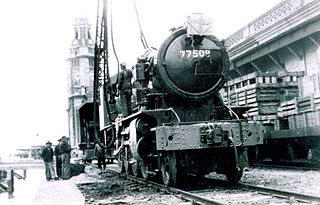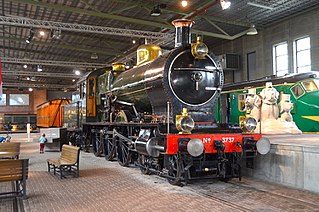
The London, Midland and Scottish Railway (LMS) Stanier Class 8F is a class of steam locomotives designed for hauling heavy freight. 852 were built between 1935 and 1946, as a freight version of William Stanier's successful Black Five, and the class saw extensive service overseas during and after the Second World War.

The War Department (WD) "Austerity" 2-8-0 is a type of heavy freight steam locomotive that was introduced in 1943 for war service. A total of 935 were built, making this one of the most-produced classes of British steam locomotive. They were nicknamed Ozzies by the railwaymen.

The Longmoor Military Railway (LMR) was a British military railway in Hampshire that was built by the Royal Engineers from 1903 to train soldiers on railway construction and operations. The railway ceased operation on 31 October 1969.
The United States Army Transportation Corps S160 Class is a class of 2-8-0 Consolidation steam locomotive, designed for heavy freight work in Europe during World War II. A total of 2,120 were built and they worked on railroads across much of the world, including Africa, Asia, all of Europe and South America.

The War Department (WD) "Austerity" 2-10-0 is a type of heavy freight steam locomotive that was introduced during the Second World War in 1943.

The Hunslet Austerity 0-6-0ST is a class of steam locomotive designed by Hunslet Engine Company for shunting. The class became the standard British shunting locomotive during the Second World War, and production continued until 1964 at various locomotive manufacturers.

Longmoor Military Railway number 600 Gordon is a preserved British steam locomotive. It was built during World War II to the War Department "Austerity" 2-10-0 design and was the last steam locomotive owned by the British Army. It had the same power output as the Austerity 2-8-0 but a lighter axle load, making it suitable for secondary lines. The middle driving wheels of the class have no flange, to ease turning on tighter tracks.

The Railway Museum in Utrecht is the Dutch national railway museum. It was established in 1927 and since 1954 has been housed in the former Maliebaan station.

The Statens Järnvägar Class G11 was a class of two ex-British War Department Austerity 2-8-0 steam locomotives, numbered 1930 and 1931. They were both purchased in 1953 from Nederlandse Spoorwegen.

The SR USA class are some ex-United States Army Transportation Corps S100 Class steam locomotives purchased and adapted by the Southern Railway (SR) after the end of the Second World War to replace the LSWR B4 class then working in Southampton Docks. SR staff nicknamed them "Yank Tanks".

The NS 8800 was a series of tank engines of the Dutch railway NS for the shunting service. Of the approximately 324 British-built Hunslet Austerity C (0-6-0ST) saddle tank locomotives, many were used by the British War Department during their fight against the German army in mainland Western Europe. The NS bought 27 of them just after World War II. They had been built by the Hunslet Engine Company (12), WG Bagnall (3), Robert Stephenson & Hawthorns (RSH) (6), and Hudswell Clarke (6).

The British Railways (BR) ex-WD Austerity 2-10-0 Class was a class of 25 2-10-0 steam locomotives of the WD Austerity 2-10-0 type purchased in 1948 from the War Department.

War Department "Austerity" 2-8-0, WD No. 79257 is a preserved British steam locomotive. It is the only survivor of its type. Originally built by the Vulcan Foundry in 1945, works No. 5200, it was given the WD No. 79257. During the liberation of Europe, it was transferred to mainland Europe with the British Army.

The Kowloon-Canton Railway class of ex-WD Austerity 2-8-0 was a class of 12 steam locomotives, ex-WD Austerity 2-8-0. Unlike other KCR locomotives, they apparently did not receive a class letter designation.

The NS 3700 class was a class of express steam locomotives with the wheel arrangement of 2'C (4-6-0) of Nederlandse Spoorwegen (NS) and its predecessor Maatschappij tot Exploitatie van Staatsspoorwegen (SS).

The NS 4300 was a series of steam locomotives of the Dutch Railways (NS), taken over from the British War Department.

The NS 5000 was a series of steam locomotives of the Dutch Railways (NS), taken over from the British War Department.

The NS 4000 was a series of express steam locomotives of the Dutch Railways from 1945 to 1956.

The NS 7700 was a series of tank engines of the Dutch Railways (NS) and its predecessor the Hollandsche IJzeren Spoorweg-Maatschappij (HSM).
















